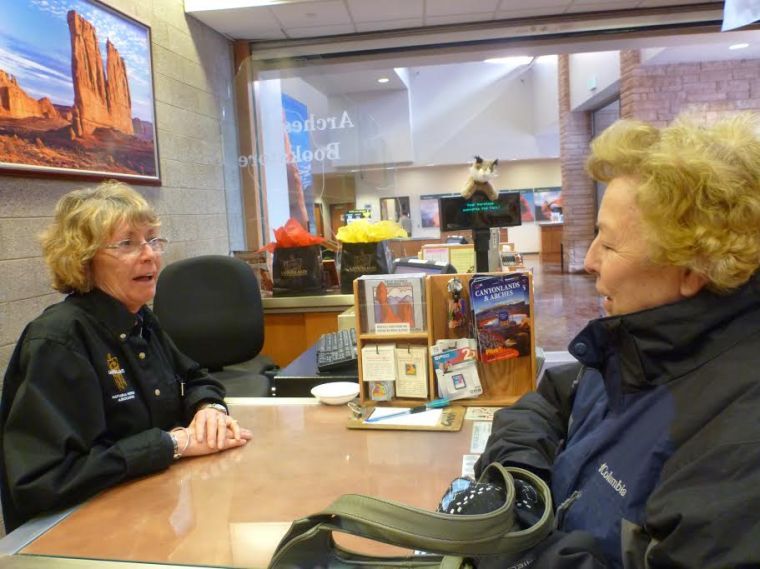The federal government shutdown during October 2013 was a setback in an otherwise strong year for Moab’s economy, said area business owners.
Last autumn, Congress failed to reach a budget deal for the 2014 fiscal year, resulting in a 16-day partial shutdown of the federal government. On Oct. 1, government agencies closed their doors and sent the majority of employees home. National parks were shuttered. Bureau of Land Management (BLM) and U.S. Forest Service campgrounds, picnic areas and other facilities were closed. Tourists and businesses alike scrambled to salvage what they could of the last month of the season.
By Oct. 8 Moab Area Travel Council executive director Marian DeLay estimated that county businesses had lost $2.6 million in revenue. The Grand County Council declared a local state of emergency and began exploring creative options to reopen federal lands.
On Oct. 10 Governor Gary Herbert announced an agreement between the State of Utah and the National Park Service that enabled the parks to open — through state’s funds of $166,572 a day, for up to ten days. Seven days later, regular government operations resumed, but for many of Moab’s commercial businesses, the damage had been done.
“We were on pace to do really, really well but kind of got the rug pulled out from under us in the end,” said Darren Vaughan, co-owner of Tex’s Riverways, who had to cancel river trips that used rivers inside of Canyonlands National Park’s boundaries.
As visitors heard the news of park closures, many canceled their travel plans despite efforts to steer them to alternative recreation areas.
“We had two large groups cancel that come to Moab on a national parks tour. And then I had two rental groups cancel that were going into still water and canceled because the jet boat service wasn’t running,” said Don Oblak, owner of Canyon Voyages.
Both river companies, like many other outfitters, were still able to use BLM land.
“The BLM basically said if you can come and go without dealing with us, come and go. That gave us a plan B. They weren’t as big a money maker as the trips going into the park but it gave us a lifeline,” Vaughan said.
Other outfitters using non-park lands saw an initial increase in business when the parks closed.
“People were calling us who may not normally do the type of activities we offer. But they were looking for things to do and they saw as a great alternative,” said Brett Sutteer, owner of Moab Cliffs and Canyons who runs climbing and canyoneering trips on BLM and state lands.
Retail stores in Moab also benefited as visitors already in town looked for ways to change their plans.
“The first few days of the shutdown we actually saw a pretty good increase in business. People couldn’t go into the parks and were looking for other things to do and some went shopping,” said Andy Nettell, owner of Back of Beyond Books.
But as the shutdown continued, most of these businesses saw a decline in their numbers.
“I think where the shutdown hurt us most was in the second half of October where the last minute planners who hadn’t booked trips bailed entirely because they couldn’t go into the parks,” Vaughan said.
Nettel saw a decrease in traffic.
“On the bottom line we probably saw a 20 to 25 percent drop in sales that I can attribute to the shutdown,” Nettel said.
Business may have declined due to the closure of the national parks, but October events kept people coming to town, such as Outerbike, Plein Air, and the Other Half Marathon.
Though Moab’s economy is often seen as dependent on the single industry of tourism, diversity does exist within that industry.
“We have the park visitors, we have the climbers, we have bikers, they all have different reasons for coming,” said Ken Davey, economic development specialist for the City of Moab. “We weathered the shutdown better than what many of us thought we would.”
Even with the partial government shutdown, Moab’s economy grew last year, continuing a trend since 2009.
Visitation to Arches National Park rebounded after the October closure, with a 21-percent increase in November over the year before and a 14-percent increase in December compared to the year before.
The Utah State Tax Commission’s report on taxable sales shows an increase for the first three quarters compared to 2012 (fourth quarter figures not yet available), including a 9.58 percent increase for the third quarter.
October’s reported taxable sales for Grand County were up 12.95 percent and Moab’s were up 5.39 percent from the previous year. However, according to the State Tax Commission, the information may not reflect actual sales for the month, as some businesses file sales reports on a monthly basis and others file quarterly.
However, restaurant sales appeared to drop, as the tax collected in 2013 was $25,000, as compared to $31,000 the year before.
“This was a great year for us. It was our best year in terms of gross sales, in terms of numbers we took on the river, and it was our highest in terms of employment payroll. It was a great year. And then it ended up a little bit tainted,” Oblak said.
Sales tax revenues and visitation up in 2013
“We were on pace to do really, really well but kind of got the rug pulled out from under us in the end.”




